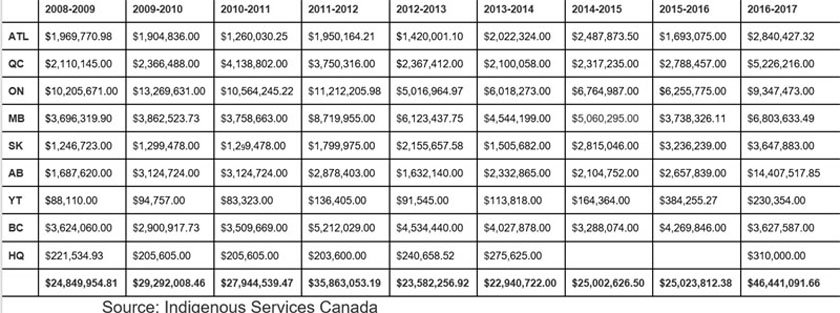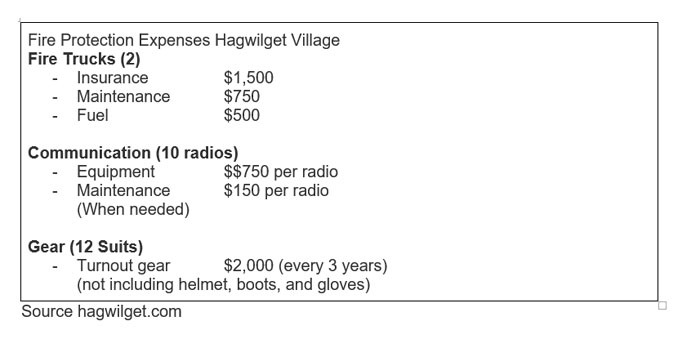|
|

|
  
Features
2018/11/15
First Nation
FIRST NATIONS FIRE SAFETY: ISC FIRE PROTECTION FUNDING AND A VIEW FROM COMMUNITIES
This story is brought to you in part by
 By Cori Marshall
By Cori Marshall
Addressing fire protection needs on reserve can be complicated. The federal government provides funding for specific fire protection needs, though federal dollars do not cover the entire country. Indigenous Services Canada (ISC) doesn't provide fire protection funding for Inuit communities. Fire protection support for these communities comes from the territorial or provincial governments. In the NWT, responsibility for fire protection falls under the Department of Municipal and Community Affairs for both First Nation and Inuit communities.
WaterToday reached out to Indigenous Services Canada (ISC) to find out more about their commitment, in supporting First Nations communities fire protection, and the funding itself. More importantly, we reached to several communities across Canada to get their reaction to the process.
Federal fire protection funding for First Nations is provided through the First Nations Infrastructure Investment Plan (FNIIP). William Olscamp, Spokesperson for ISC, said that "virtually every on-reserve First Nations Community applies for FNIIP funding."
The FNIIP is based on investment plans that each community produces every year, "which outlines their planned expenditures for community infrastructure requirements, including fire protection services," Olscamp added.
He explained that "the level of funding is then determined by many factors such as the number of buildings on-reserve, remoteness, population and environmental factors."
Funding varies from region to region and year to year. The chart below breaks down the fund allocations.

Though ISC provides funding for capital purchases, awareness programs, and training, once money has been allocated to a community "it is at the Chief and Council's discretion to manage these funds," Olscamp said. He underlined that ISC "does not determine expenditures except in particular circumstances.
Olscamp told us that ISC has "invested more than $3.7 million to install more than 128 thousand working smoke alarms." Since 2016 ISC has "funded 89 fire protection programs that benefit 235 communities."
The Joint First Nations Fire Safety Protection Strategy 2016-2021, which was introduced in partnership with the Aboriginal Firefighters Association of Canada (AFAC), provides for the funding of on-reserve fire protection services and initiatives.
"The goal of this five-year Strategy is to support on-reserve communities in reducing the risk of fire-related deaths and injuries and losses to critical infrastructure on reserve by promoting initiatives that focus on preventing fires before they start."
William Olscamp, ISC Spokesperson
The ISC Spokesperson said that "The Strategy focuses on four pillars: Partnership for First Nations Fire Protection, Fire Prevention Programs, Community Standards, and Fire Service Operational Standards."
The strategy takes into consideration "First Nations communities on-reserve with limited fire protection services due to remoteness, reduced population, or limited capacity to sustain a fire service or Municipal Type Service Agreement," Olscamp said. ISC focuses on these communities for "cost-effective" programs, to increase awareness and increase protection.
As WaterToday has reported lack of adequate housing is central to the situation of on-reserve fire safety. Improving housing conditions is a "key component" to the Strategy. "Safe and adequate housing is critical not only regarding fire prevention and protection but also in addressing health and socioeconomic issues such as overcrowding and helping to build stronger and more sustainable communities," Olscamp said.
Urgent housing needs were addressed with an allocation of "$554.3 million over two years", for 2016-2017. The initial funding "is being followed up by $500 million over three years to support First Nations housing on reserve as part of a 10-year Housing Strategy that is being developed with First Nations."
We reported that the situation had not improved significantly in two years, we asked ISC if they had observed any tangible improvement. Oscamp replied that "ISC does not keep records of fire incidents on reserve but recognizes the value of such data."
ISC is working with AFAC along with other partners "to determine how best to have fire incident data captured, analyzed and shared for program design and policy development purposes." Blaine Wiggins, AFAC Chief Executive Director, said that is "under ongoing planning."
Halalt First Nation, in British Columbia (BC), has a population of 160, and 43% of the 35 households were in need of major repairs based on 2011 census data. Lonnie Norris, Assistant Director of Operation, said that the community has "no fire hall, no trucks, [and] no equipment." Halalt does have an agreement with the District of North Cowichan that provides fire protection.
The community's overall budget is $2,400, $15 per person. Norris informed WaterToday that "the cost of fire protection is generally $4,000 per year."
"The funding is never adequate, and more federal investment is needed."
Lonnie Norris, Assistant Director of Operations, Halalt First Nation
Census data shows that Hagwilget, in BC, had a population of 235 in 2011. There are 75 households, 67% of which were in need of major repair. According to the Hagwilget Village Council website, there is "a volunteer fire department."
The federal money that the Village receives is based on population, which is "approximately $5,500 a year." The Village operates a fire hall as well as two trucks, one of which is "nearing the end of its usefulness. Hagwilget spends an average of $8,500 a year "and it's still not enough."

Madawaska Maliseet First Nation, in New Brunswick, had a population of 90 in 2011. There were 65 households, and 23% were in need of major repair.
Sal Poirier, Environmental and Emergency Preparedness for Madawaska Maliseet First Nation, said that the community uses "the local municipal emergency [fire] service." He added "we own no trucks or equipment, no building," no training is provided in the community.
Poirier told WaterToday that the community submitted its emergency plan "to INAC last year and I have not yet received any feedback."
ISC provides federal funding for on-reserve fire protection services and initiatives and works in partnership with AFAC as it develops programs that target lack of awareness. There is still a shortfall when it comes to funding.
Halalt First Nation and Hagwilget Village struggle financially to provide the full range of fire protection service the communities need.
cori.marshall@watertoday.ca
|
|
|
Have a question? Give us a call 613-501-0175
All rights reserved 2025 - WATERTODAY - This material may not be reproduced in whole or in part and may not be distributed,
publicly performed, proxy cached or otherwise used, except with express permission.
|
| |